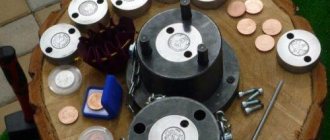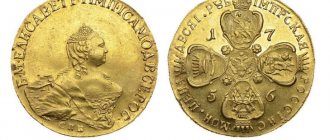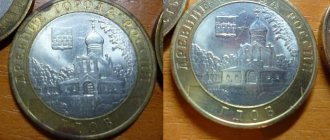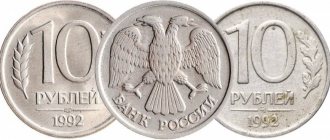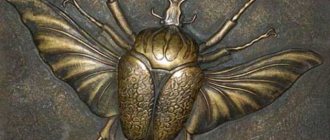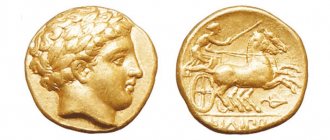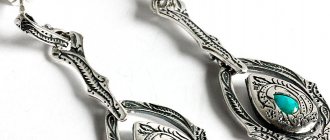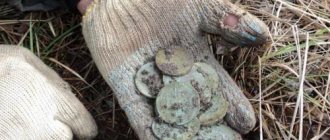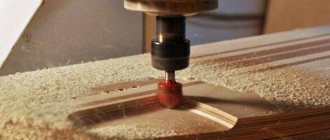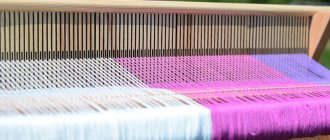Coin making is one of the most ancient arts. And like any type of art, it developed along with man. Over the years, views on beauty have changed, technology has improved, and the situation in the world has changed. All this was reflected in the history of coinage.
Nowadays, coin production is an almost completely automated process. But how did man come to this, and what stages did this ancient art go through? In this article we will go through the history of coinage. We'll tell you where the first coins appeared, what the old medal makers became famous for, and how coins are made today.
Ancient world
Before the creation of coins, people in different countries used what had great value. In some places the medium of exchange was cattle, in others weapons, and in some countries they even used sugar and ivory. To streamline trade and exchange, a state means of payment was needed. That's what coins became.
Medal art originated at the end of the 8th - beginning of the 7th century BC. Coins first appeared in Lydia and Ancient Greece. They were made by minting an alloy of gold and silver and were even stamped.
Medal art began to develop rapidly in Greece. Many works of that time have reached us, but few names have survived. We only know those that were indicated on the coins. These are such masters as Kimon and Evainet, who worked under Dionysius.
The profession of a medalist has become respected. In Rome, medalists were at each mint, they had their own corporation and leader. In Greece, engravers were engaged in creating designs for coins. They engraved the image directly onto the precious stones.
Ancient coins, compared to modern ones, were distinguished by high high relief and irregular shape of the coin circle. At the same time, Roman coins were seriously inferior to Greek ones in terms of artistic beauty, but were closer to modern ones due to their roundness and bas-relief.
Composition of coins - what metals and alloys they are made of
- Bimetal: steel clad with cupronickel - 1.5 kopecks
- Bimetal: copper clad with cupronickel - 5 rubles (until 2009)
- Bimetal: steel clad with tombak - 10, 50 kopecks (since 2006)
- Brass (copper-based alloy with the addition of zinc) - 10.50 kopecks (until 2006)
- Steel with brass galvanizing - 10 rubles; 10.50 kopecks (2014-2015)
- Nickel galvanized steel - 1, 2, 5 rubles (since 2009)
- Copper-nickel alloy - 1.2 rubles (until 2009)
Middle Ages
In the Middle Ages and until the Renaissance, the medal art of Europe was undeveloped: the coins had a flat relief, the coin itself was thin and looked like a metal plaque. True, there is an exception to this rule.
In the German states of the 12th century, coins were still of high artistic quality. And such bracteates flourished during the time of Frederick I Barbarossa.
Stamps for coins were then made by professional engravers. The coins even reflected the style of that era - they can be attributed to late Romanesque art. The coins depicted figures of rulers and saints in a symmetrical frame of architectural elements. Although the figures were stylized, the small details on them were carefully worked out - armor, clothing, attributes of power.
Kievan Rus
In Kievan Rus, coins of Prince Vladimir, Prince Svyatopolk and Yaroslav the Wise were engraved by Byzantine masters. But at the beginning of the 9th century, they stopped minting coins in Rus'.
There were several reasons for this: Rus' broke up into separate principalities, and there was no need for a single state coin. And later, during the yoke, the country experienced economic and political decline. As a result, medal art was forgotten for a while.
Where the medallions for coins of the 13th-15th centuries came from remains a mystery. What is known is that under Ivan III, Aristotle Fioravanti was discharged from Italy. In addition to creating architecture, the master also engraved coins.
Solid
Roman Empire, 4th century AD e.
Solidus of Emperor Valentinian II. 375–378 Yorkshire Museum / Wikimedia Commons
The Roman monetary system, especially during the Late Empire, was very complex: gold, silver and copper coins, imperial and local, coins of various emperors and usurpers, recognized by some and not recognized by others... The situation is especially confusing began after the so-called crisis of the 3rd century - a period of incessant wars and the collapse of the state. Emperor Diocletian (reigned from 284 to 305), in order to restore unity and order, had to carry out reforms that changed the empire almost beyond recognition. One of them was the introduction of a new imperial gold coin, the solidus. The coin came into widespread circulation already under Diocletian’s successors, primarily under Constantine the Great, and now the solidus is associated primarily with his name.
The Konstantinov solidus weighed about 4.5 grams and was minted from the purest gold. Its widespread distribution and persistence helped to more or less stabilize prices in the empire, and with them public finances. The very name solidus (Latin for “solid” - from the same word “solid” and “solidarity” come) was supposed to emphasize its reliability.
The gold from which solidi were minted was mined in the eastern part of the Roman Empire. With its final collapse in the 5th century, gold coins in the West almost disappeared. The barbarian kingdoms and the empire of Charlemagne had to be content with silver money. In the East, in Byzantium, the minting of solidi continued - there they were called nomismas (Greek νόμισμα - “coins”, “currency”). Over the next five centuries, nomismas (in the West they were called bezants, from the name of Byzantium) were the main currency of the Mediterranean. It was in imitation of them that the Arabs began to mint gold dinars from the end of the 7th century.
From the 11th century, Byzantine emperors, mired in ruinous wars, began to reduce the gold content of nomisma. As a result, already in the 13th century, it depreciated so much that the Italian city-states, prospering thanks to Mediterranean trade, had to start issuing their own stable gold coins - florins and ducats.
From the Latin name solida came the designations of several later monetary units, including the French sols (aka sous) and the Italian soldos. In addition, in the Old French language, the word “balance”, derived from “solid”, began to refer to the balance of payments, as well as payment to hired soldiers - soldiers.
Renaissance
During the Renaissance, the art of coinage in Europe was revived. Venetian medals and the name of the painter Antonio Pisano, who during this period cast medals for the Byzantine emperor, have reached us.
Then other great masters appeared - Leone Leoni, Sperandio di Mantova, Maria Pomedello, Jean Duan, Annibale Fontana... They made coins from bronze and relied on the style of ancient examples.
In Germany at that time, the first religious scenes appeared on coins, thanks to Albrecht Dürer, Heinrich Reitz, Friedrich Hagenazer and other great masters.
Russia
As for Russian coins, there were no elegantly engraved coins in Russia until Peter I. Only under him did they begin to send medalists to Russia and order the production of coins. It was by order of Peter I that the first series of commemorative medals dedicated to the Great Northern War was created.
And during the time of Catherine II, attention was first paid to the artistry of coin making. At the same time, a medal class was founded at the Imperial Academy of Arts. It was led by the Frenchman Pierre-Louis Vernier.
Timofey Ivanov became the leading medalist in Russia in the 18th century. He made many medals and memorial signs dedicated to historical events under Peter I and Catherine II.
Under Alexander I and Nicholas I, the talent of the medalist Count F. P. Tolstoy was noted. He made medallions dedicated to the events of the Patriotic War of 1812.
About coin minting technology
The making of a coin always began with the creation of a sketch. Then, based on the sketch, a molded model was created from sculptural plasticine. This model was sculpted on a board using special pointed sticks of different sizes. The sculpted model did not yet quite correspond to the future product - it was 3-4 times larger than the intended coin.
A plaster cast was then cast from the model. And from the plaster cast they made a new casting from hard cast iron using the galvanoplasty method. Next, a steel punch was made from the convex model using a pantograph - an engraving machine. Its format already corresponded to the designed medal or coin.
Then, if necessary, the master corrected the image with a graver. After all, only by using manual labor can a product be given life. Then the punch was hardened and used to extrude a matrix or stamp, with which coins or medals were minted.
This technology for creating coins came to us from past centuries. Some mints still use it, while others completely automate production. But there are many other processes in coinage that directly affect the appearance of the coin and its quality.
Calculation of financial results
It is also very important for a potential businessman how profitable the coin business is. Calculations must be made based on the selected work format. For example, if a minting machine were located in a park with a foot traffic of 35,000 people, about 2,600 souvenir coins could be sold per season.
The equipment will cost 50–60 thousand rubles, including the cost of blanks for coins. But you need to remember that templates should be updated over time in order to attract new and already loyal customers.
The average cost of one coin is 150 rubles. For 2600 coins you can get 390,000 rubles. If we take into account that this profit will be received in 4 months (from May to August), then the monthly income will be 97,500 rubles. It turns out that the payback with proper organization of work is only a few weeks. The profitability of such a business is about 30%. The net profit for the month will be 30–35 thousand rubles. But this is not the maximum value; everything will depend on individual parameters (location, size of the city, number of tourists).
Making souvenir coins is a profitable and fairly simple business that even those who have never been involved in entrepreneurship can try themselves in.
The quality of coinage - what is the difference?
The division of coins according to the quality of mintage came to us from England. This classification divides coins into two main types: those made in normal quality and those in improved quality. Let's figure out what this difference is.
Coins of ordinary quality are called uncirculated
. This is the quality used to make the coins that we use in monetary circulation, as well as some investment coins.
They are made in automated production in large quantities and little manual labor is used. Therefore, the requirements for the appearance and design of uncirculated coins are small. They should be the same weight, thickness and diameter, with a simple pattern. In general, something that is just suitable for large print runs at low costs.
As a rule, coins of uncirculated quality have a metallic sheen over the entire surface. They do not have mirror surfaces, the relief does not stand out, and there are no small details in the drawings. According to the classification, small bevels on the edging edges, small scratches or stains are allowed on such coins. These damages occur due to minting in large quantities.
An improved type of uncirculated coins is called diamond-uncirculated
. They have a smooth and shiny surface, the designs are more detailed and elaborate. These coins are no longer susceptible to chips or scratches.
The next type of coin quality is the highest, or proof.
Coins of this quality are produced in small editions and with a high proportion of manual labor. The master carefully studies each stamp to obtain a smooth mirror surface and a contrasting matte pattern on it.
The peculiarity of the proof quality lies in the minting process itself - in order for the design to be perfect, the stamp must hit the workpiece twice. As a result, we get a product that has no scratches or irregularities. Proof coins are the most valuable: both for the artistry of their execution and for the quality itself.
Another type of coin quality is proof-like
, or similar proof. These coins are similar in appearance to proof coins, but their minting technology may differ. For example, the workpiece could be struck once. Proof coins are also valuable and are in demand among collectors and numismatists.
Why is gold still used today?
The production of gold signs continues to this day, but in limited quantities. A distinctive feature of gold is the difficulty of counterfeiting - the natural properties of the material allow you to quickly find out how natural the product is in human hands. Such coins can be distinguished from other alloys by their appearance, weight, and size.
Precious metals have fluctuating values, making them a great long-term investment option. Sometimes people confuse copper with gold, but the counterfeit is easy to spot - copper coins are much less durable than gold coins.
Products can be returned to circulation by selling at a favorable price, but then any manipulations with coins will be clearly visible. Often, scammers make subtle cuts, chips, and trim off part of the gold, reducing the original dimensions and weight of a unit of production.
